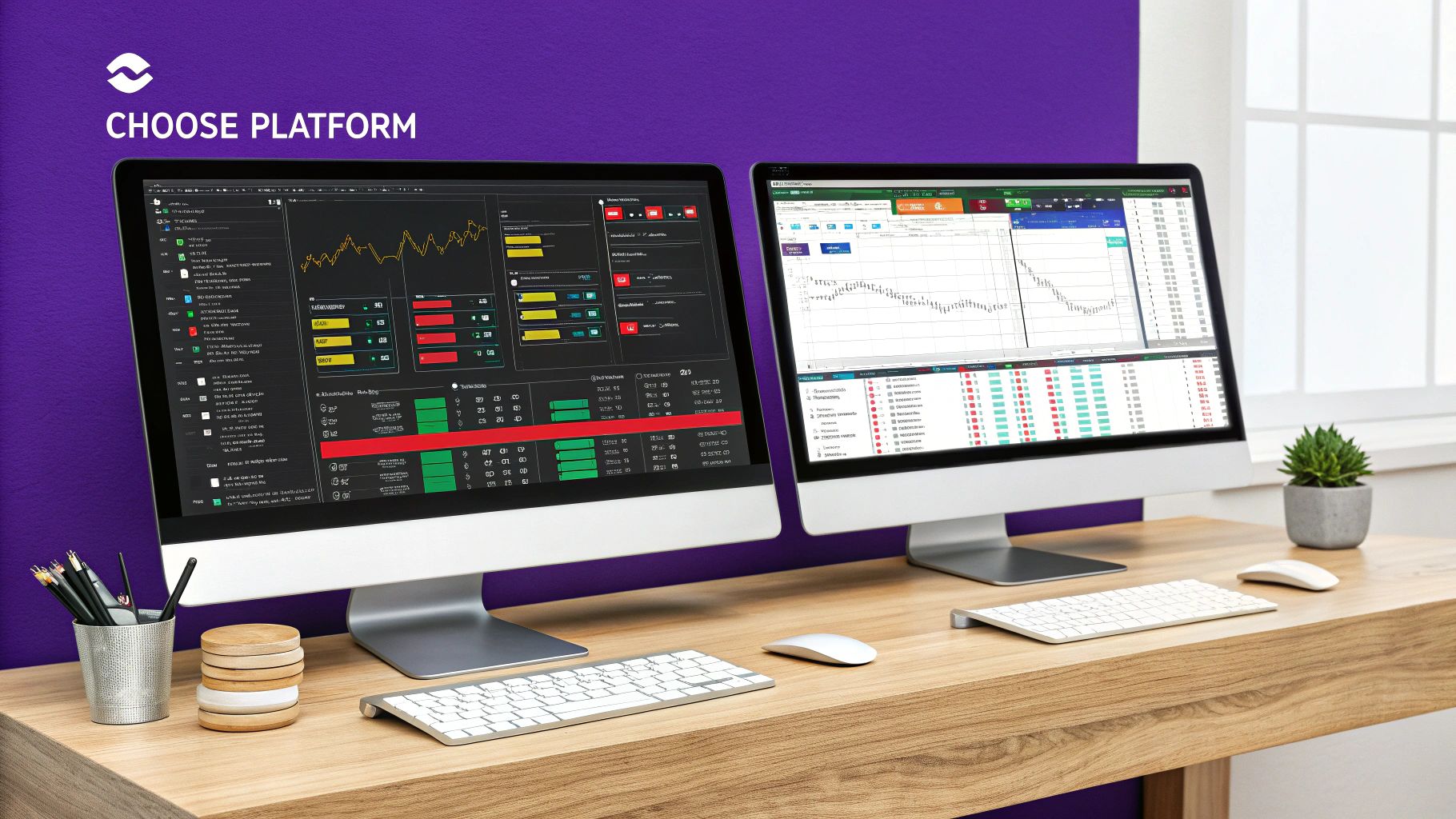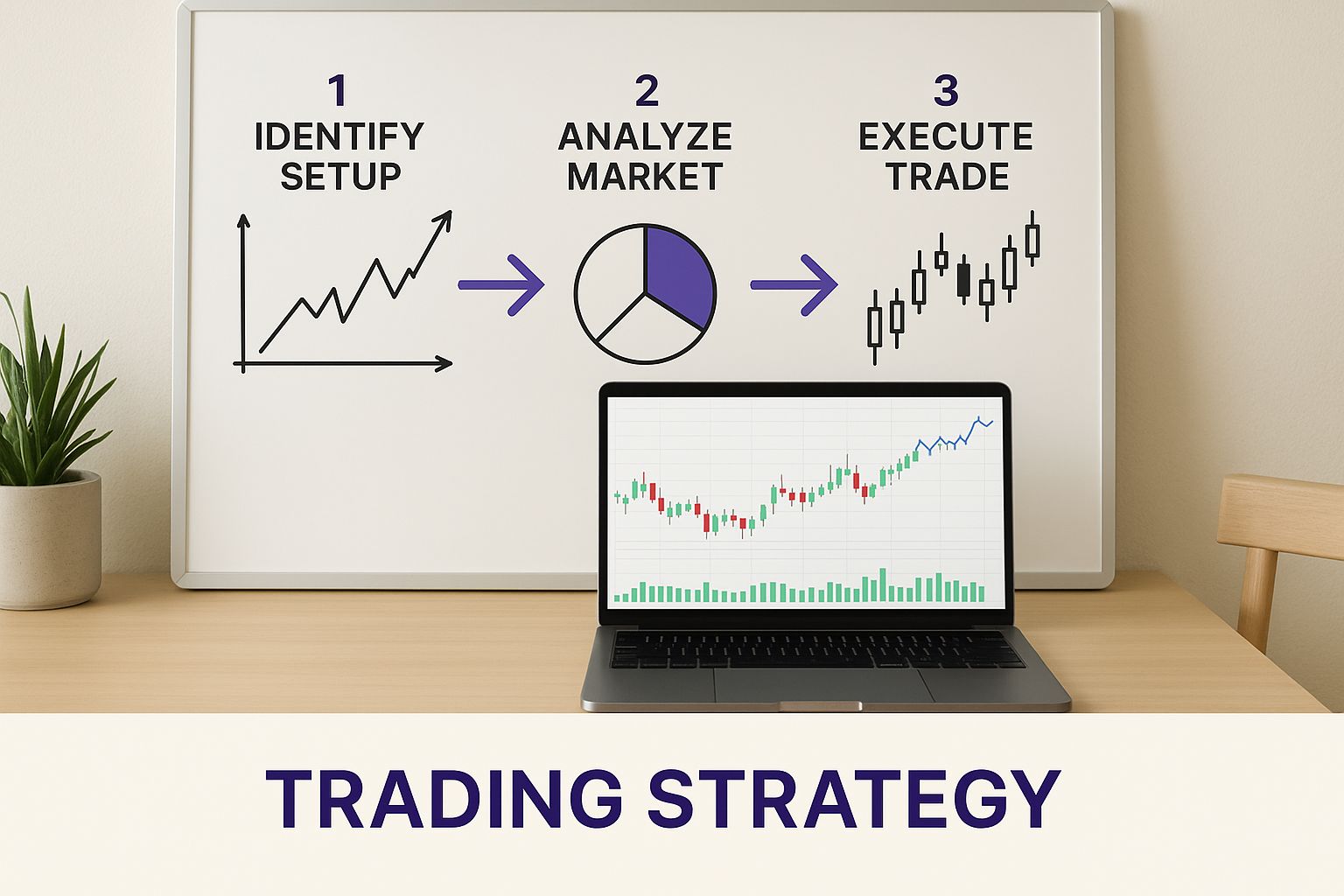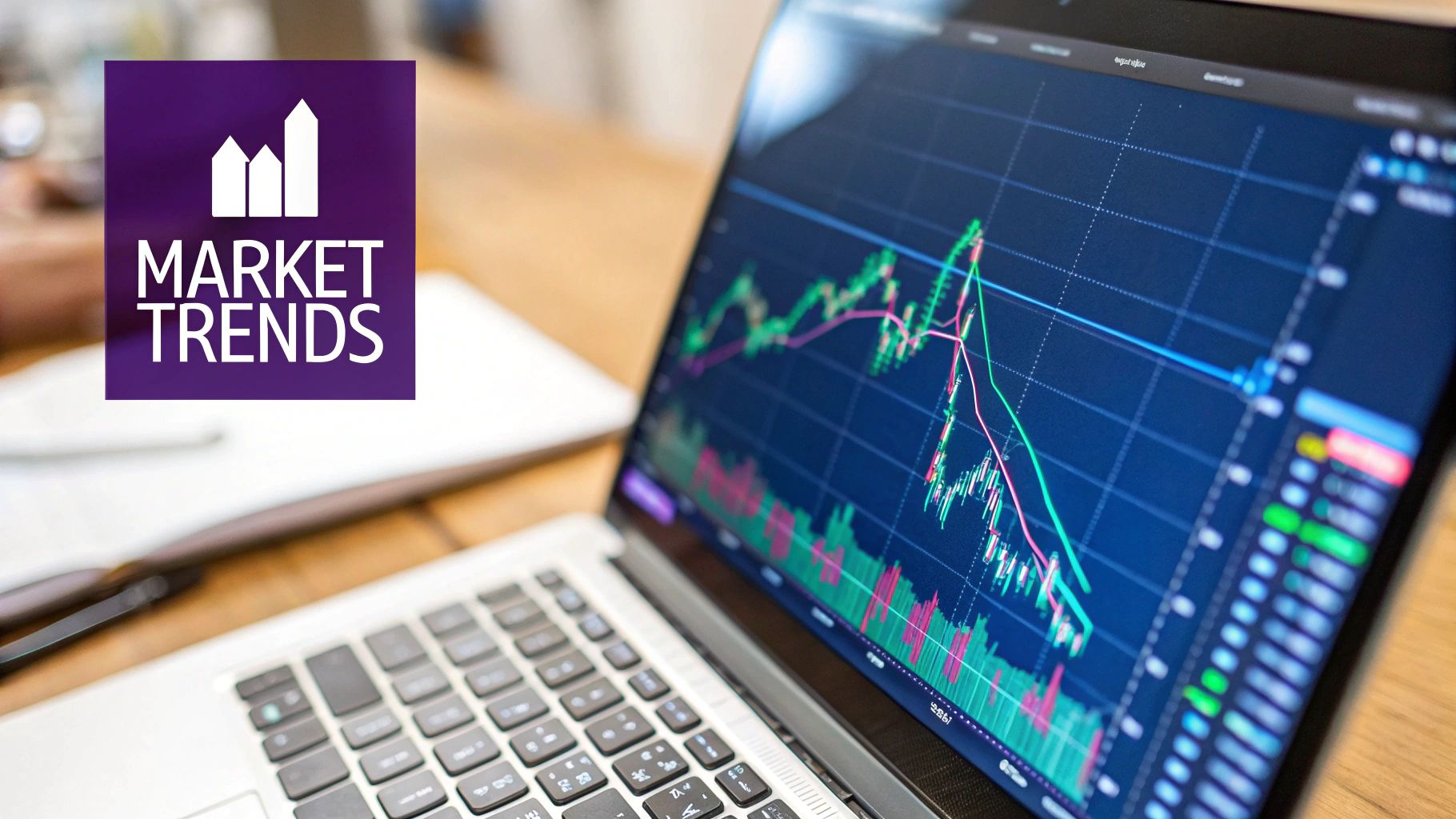So, you want to trade crypto. In simple terms, it means opening an account on a platform like vTrader, funding it, picking a digital asset like Bitcoin or Ethereum, and then placing an order to buy or sell.
We’re going to walk through each of these ideas with clear, practical advice. The goal is to get you feeling confident before you ever risk a single dollar.
Getting Started Without Getting Overwhelmed
Diving into crypto trading can feel like trying to learn a whole new language overnight. But here’s the good news: you don’t need to be a financial genius to get started. The core concept is pretty straightforward—you're buying a digital asset with the hope that its value goes up, letting you sell it later for a profit.
Cryptocurrencies are just digital tokens that use cryptography to stay secure. Unlike the dollars or euros issued by governments, they run on a decentralized technology known as a blockchain. You can think of a blockchain as a shared public spreadsheet that logs every single transaction, making everything transparent and incredibly difficult to alter.
It's this unique structure that gives crypto its appeal and has sparked massive growth in the market.
Why Is Everyone Talking About Crypto Trading?
The global cryptocurrency market was recently valued at around USD 5.7 billion. Projections show it’s on track to more than double, hitting USD 11.7 billion by 2030. You can read the full cryptocurrency market projections to see the scale for yourself. Even with all the market swings, this kind of growth shows that crypto is becoming a serious part of modern finance.
Trading crypto brings a few key advantages to the table:
- Always On: The markets never sleep. They're open 24/7, which means you can trade whenever and wherever you want, right from the vTrader app.
- Volatility: This is a double-edged sword. While it brings risk, the high volatility also creates chances for big gains in a short amount of time.
- Transparency: Every transaction is out in the open on the public blockchain, which means there’s a high degree of transparency you don’t always get elsewhere.
Essential Crypto Terms for New Traders
Get comfortable with the language of crypto. This table breaks down key terms you'll encounter daily on the vTrader platform.
| Term | What It Means on vTrader | Why It's Important |
|---|---|---|
| Blockchain | The secure, decentralized ledger where all crypto transactions are recorded. | It’s the foundational technology that makes crypto possible, ensuring transparency and security for all your trades. |
| Bitcoin (BTC) | The original and most well-known cryptocurrency. Often seen as a benchmark for the entire market. | Understanding BTC's movements can give you a pulse on the broader crypto market sentiment. |
| Ethereum (ETH) | The second-largest cryptocurrency, known for its smart contract capabilities that power DeFi and NFTs. | ETH is more than just a currency; its ecosystem offers diverse trading and investment opportunities. |
| Volatility | The measure of how quickly and dramatically a crypto's price can change. | High volatility means higher risk, but it also creates the potential for significant profits (or losses). |
| Wallet | A digital location where you store your cryptocurrencies. vTrader provides a secure, integrated wallet. | Your wallet is where your assets live. Securing it is your top priority. |
Knowing these terms is your first step. It's the difference between feeling lost and feeling like you belong in the conversation.
Creating Your vTrader Account
First things first, you need a secure home base for your trading. Setting up a vTrader account is designed to be quick and, more importantly, safe. You'll start with the basics—your name and email—and then you’ll create a strong, unique password.
From there, it's all about security. vTrader will guide you to set up Two-Factor Authentication (2FA). This is non-negotiable. It adds a critical layer of defense, meaning that even if someone manages to steal your password, they can't get into your account without your phone.
Expert Tip: I always recommend using an authenticator app like Google Authenticator for 2FA instead of SMS messages. It's a far more secure method and protects you from common "SIM-swapping" scams.
Finally, you’ll go through a quick verification process called Know Your Customer (KYC). This involves uploading a government-issued ID. It might feel like a bit of a chore, but it's a standard regulatory step that helps us prevent fraud and keeps the platform safe for everyone involved.
Once you’re verified, you’re in. Before you do anything else, I highly recommend just clicking around and exploring the platform. The best investment you can make right now is in your own knowledge. For a deeper dive into the core concepts, check out the guides in the vTrader Academy. Getting comfortable before you deposit your first dollar is the smartest move any new trader can make.
Funding Your Account and Placing Your First Trade

With your vTrader account set up and secured, it's time to put it to work. This is the moment where the rubber meets the road—moving from theory to actual trading. Before you can jump into the market, you need to fund your account, and vTrader gives you a couple of direct ways to do it. The best choice for you often boils down to a classic trade-off: speed versus cost.
If you're just getting started, you can move cash straight from your bank using an ACH transfer or a wire. It’s a familiar process, much like funding any other brokerage account, making it a great on-ramp for those converting fiat currency (like USD) into crypto for the first time.
For those who already hold crypto in another wallet or on a different exchange, a direct crypto deposit is your other option. This is typically the fastest route and is ideal for seasoned traders looking to consolidate their assets and take advantage of vTrader’s zero-fee trading environment.
Choosing Your Funding Method
So, which path should you take? A bank transfer is straightforward but be prepared to wait a few business days for the funds to clear before you can trade. It’s reliable, just not instant.
A crypto deposit, on the other hand, is lightning-fast. Transactions on blockchains like Bitcoin or Ethereum usually confirm in minutes, not days. To make a deposit, you'll just need to grab the unique vTrader wallet address for the specific coin you want to send.
Here’s a quick rundown on finding your deposit address:
- Head over to the "Wallet" or "Deposit" section in your account.
- Pick the crypto you plan to deposit, for example, Bitcoin (BTC).
- The platform will generate a unique deposit address—it’s a long string of letters and numbers.
- Carefully copy that full address and paste it into the "send" or "withdraw" field of the wallet or exchange you're sending from.
Crucial Tip: Always double-check—or even triple-check—that wallet address before hitting send. Sending crypto to the wrong address is like putting cash in the wrong envelope and mailing it; those funds are almost always gone for good. Make sure you’re sending on the correct network, too (e.g., sending ETH on the Ethereum network).
Placing Your First Trade The Smart Way
Once your account is funded, the real excitement begins. You're ready to execute your first trade, but this is where discipline really counts. On vTrader, you'll mainly encounter two core order types: Market Orders and Limit Orders. The difference between them is fundamental to controlling your entry price and managing your risk.
A Market Order is as simple as it gets. It tells the exchange to buy or sell for you immediately at whatever the best available price is at that exact moment. It’s all about speed.
A Limit Order puts you in the driver's seat. You set the exact price you’re willing to pay (to buy) or accept (to sell). Your trade will only go through if the market hits your price. It's all about precision. You can see a complete overview of the fee structures for different order types on the official vTrader fees page.
Market vs. Limit Orders in Action
Let’s walk through a real-world scenario. Say Bitcoin (BTC) is trading around $60,000, but some market news just dropped that you think might cause a quick, temporary dip.
-
Market Order Scenario: You’re convinced the price will snap back fast and you want in now. You place a market order to buy 0.01 BTC. The order fills almost instantly, perhaps at an average price of $59,850 as the market wiggles. You got in, and you got in fast. Mission accomplished.
-
Limit Order Scenario: You have a hunch BTC will fall a bit more, maybe down to $59,000, before it rebounds. You place a limit buy order for 0.01 BTC right at the $59,000 mark. Now, you wait. If the price touches your target, your order gets filled. But if it only drops to $59,200 and then shoots back up, your order never executes, and you miss the move.
Think of it this way: market orders are for "get me in now," while limit orders are for "get me in at this specific price, or not at all." For new traders, getting comfortable with limit orders is a great way to build discipline and avoid getting caught up in FOMO-driven price spikes.
Mastering Crypto Order Types on vTrader
Going beyond simple buy and sell orders is where the real strategy begins. Once you get the hang of basic Market and Limit Orders, you can start using vTrader's more advanced tools to automatically manage your risk and lock in profits. This is a game-changer when you're learning how to trade cryptocurrency. It’s the difference between just reacting to the market and actively planning for whatever it throws at you.
Think of these advanced orders as your personal trading assistants, on the job 24/7. They execute your game plan even when you’re asleep or away from your desk—an absolute must in a market that never sleeps.
Protecting Your Capital with a Stop-Loss Order
The first rule of trading? Protect your capital. No exceptions. A Stop-Loss Order is your number one tool for this job. It’s a preset order that automatically sells your crypto if the price drops to a certain level, capping your potential loss on any given trade.
Let’s say you just bought one Ethereum (ETH) at $3,500, convinced it’s headed for the moon. But you’re not willing to bet the farm; you decide you can risk $150 on this idea. You can immediately set a Stop-Loss order at $3,350. If ETH takes an unexpected nosedive and hits that price, vTrader automatically sells your position. A small, manageable loss is contained before it can turn into a disaster.
A Stop-Loss isn't a suggestion; it's a hard rule you set for yourself. It strips the emotion out of the decision to cut a losing trade, a hurdle that trips up even seasoned pros.
It’s your financial safety net. You hope you never have to use it, but you’ll be damn glad it’s there when you do. Using Stop-Loss orders consistently is the hallmark of a disciplined trader who prepares for the worst while aiming for the best.
This strategic mindset is essential for navigating the volatile crypto waters. The infographic below shows how these order types fit into a foundational trading strategy.

As you can see, a solid trading plan needs clear entry and exit points. Tools like Stop-Loss and Take-Profit orders are the core components of your risk management.
Locking in Gains with a Take-Profit Order
Just as critical as cutting your losses is knowing when to cash in your wins. A Take-Profit (TP) Order does exactly what it says on the tin: it automatically sells your crypto once it hits a predetermined price target, ensuring you lock in those gains.
Sticking with our Ethereum trade, you bought at $3,500. Your analysis suggests it has a good shot at reaching $3,800. You can place a Take-Profit order right at $3,800. If the price action is in your favor and hits your target, vTrader executes the sale for you. No second-guessing, no greed, just profit.
These orders are incredibly powerful in fast-moving markets, especially in regions with high trading volumes. For example, the United States continues to be one of the largest and most active crypto markets globally. With U.S. crypto revenue hitting USD 1.35 billion recently and projected to reach USD 2.72 billion by 2030, the level of investor activity is massive. You can dig into more U.S. crypto market insights from Grand View Research.
Combining Your Orders for Total Control
On vTrader, you don’t have to pick between protecting your downside or securing your upside. You can do both at the same time with some slick techniques.
-
Bracket Orders: This is an advanced order that "brackets" your initial position with both a Stop-Loss and a Take-Profit order. When you buy your ETH at $3,500, you can simultaneously set a Stop-Loss at $3,350 and a Take-Profit at $3,800. The first price target that gets hit triggers the order, and the other one is automatically canceled. It's a "set it and forget it" approach to trade management.
-
Trailing Stop Orders: This is a dynamic Stop-Loss that follows the price up. Instead of a fixed price, you set a trailing distance, like 5% or $100. If your ETH climbs to $3,600, your trailing stop (with a $150 trail) automatically adjusts upward to $3,450. This lets your winners run while still protecting a chunk of your profits.
Getting comfortable with these order types elevates you from a passive market watcher to an active portfolio manager. It’s a vital skill for anyone serious about learning how to trade cryptocurrency successfully.
Building Your Personal Crypto Trading Strategy
Making consistent money in crypto isn't about luck or hitting a moonshot—it’s about having a repeatable game plan. Now that you know the ropes of placing orders on vTrader, it's time to move past the "how" and really dig into the "why" behind your trades.
A solid trading strategy is your personal roadmap, one that’s built around your financial goals, your schedule, and what you’re willing to risk. Trading without one is just gambling. With a strategy, you’re making calculated moves based on rules you’ve set for yourself, which is the key to sidestepping those gut-wrenching emotional decisions. Let's look at a few common approaches to see what might click for you.
Finding the Right Trading Strategy for You
The best trading style is the one that fits your life and personality, not the other way around. If you enjoy fast-paced action and can be glued to your screen, your approach will look totally different from someone who prefers to check in once a week. The goal is to find a rhythm that feels natural and doesn't keep you up at night.
I’ve put together a quick comparison to help you see where you might fit in. Think about your daily schedule and how much screen time you can realistically commit.
| Strategy | Time Commitment | Typical Risk Level | Best For |
|---|---|---|---|
| Scalping | Very High (Hours daily) | High | Traders who thrive on intense focus, quick decisions, and making dozens of small-profit trades. |
| Day Trading | High (Several hours daily) | High | Individuals who can dedicate a significant part of their day to market analysis and executing multiple trades. |
| Swing Trading | Medium (Few hours weekly) | Medium | People who want to catch larger price "swings" over days or weeks and can't watch charts all day. |
| Position Trading | Low (Check-in weekly/monthly) | Lower | Investors with a long-term outlook focused on major market trends over months or years. |
Don't feel locked into one style. Many successful traders I know started out day trading, only to find that swing trading was a much better fit for their temperament and schedule. You can always adjust as you learn. It’s all about finding what works for you.
A Primer on Technical Analysis
Technical analysis, at its core, is the art of using chart patterns and historical data to get a sense of where prices might head next. It’s an essential skill for any active trader, and you can get started with the powerful tools built right into vTrader.
It all starts with reading a basic price chart. Those green and red bars you see are called "candles." A green one means the price closed higher than it opened for that period, while a red one means it closed lower. Simple.
Trader's Insight: The goal here isn't to perfectly predict the future. No one can. Instead, think of technical indicators as tools that help you spot high-probability setups where the potential reward is worth the risk.
Once you're comfortable with charts, you can start layering on indicators to get a clearer picture:
- Moving Averages (MA): These lines smooth out price action to show the underlying trend. A popular strategy is watching for a shorter-term MA (like the 20-day) to cross above a longer-term one (like the 50-day), which can signal that momentum is shifting upwards.
- Relative Strength Index (RSI): This is a momentum tool that oscillates between 0 and 100. A reading over 70 often suggests an asset is "overbought" and might be due for a pullback. A reading below 30 suggests it's "oversold" and could be gearing up for a bounce.
These tools give you a data-driven reason to enter or exit a trade, moving you from guesswork to a calculated approach.
Creating Your Trading Plan and Journal
Think of your trading plan as the business plan for your trading career. It’s a simple, written document that spells out exactly how you'll operate. It should cover everything from the assets you trade to your non-negotiable rules for entering and exiting a position.
A solid trading plan usually includes:
- Your Goals: What are you trying to achieve? Be specific. (e.g., "Grow my account by 5% per month.")
- Risk Management Rules: This is the most important part. How much will you risk per trade? (e.g., "I will never risk more than 1% of my account on a single trade.")
- Entry Criteria: What has to happen before you pull the trigger? (e.g., "I will only go long when the price is above the 50-day MA and the RSI is below 60.")
- Exit Criteria: When do you take profits or cut your losses? (e.g., "I will set a Stop-Loss 5% below my entry and a Take-Profit target at a 2:1 reward-to-risk ratio.")
Your trading journal is the perfect partner to your plan. This is where you track everything—your entry, exit, the reasoning behind the trade, and the final outcome. It holds you accountable and, over time, reveals exactly what's working in your strategy and what isn't.
Of course, active trading isn't the only way to grow your crypto portfolio. If you prefer a more hands-off approach, you might want to learn more about how to earn rewards with crypto staking on vTrader.
Smart Risk Management to Protect Your Capital

In a market known for its whiplash-inducing price swings, your first job isn't to chase the next moonshot—it's to protect the capital you've already got. Real success in crypto trading means mastering defense long before you perfect your offense. Any trading strategy, no matter how brilliant, is doomed to fail without disciplined risk management.
This isn't about trading scared; it's about trading like a professional. Every seasoned trader I know lives by a strict set of rules. These rules are designed to ensure no single trade can ever blow up their account. It's what separates those who last from gamblers who eventually go bust.
Embrace the 1% Rule
One of the most powerful, yet brutally simple, concepts in trading is the 1% rule. The idea is dead simple: never risk more than 1% of your total trading capital on a single trade. If your account holds $5,000, the absolute most you should be prepared to lose on any one position is $50.
I know, it sounds restrictive, but this is your key to survival. It means you could be flat-out wrong ten times in a row and still have 90% of your capital ready for the next opportunity. This mindset forces you to play the long game of probabilities and preserves your account through the losing streaks that are an inevitable part of trading.
Trader's Takeaway: The 1% rule acts as a psychological safety net. It removes the gut-wrenching emotion from losses because you’ve already decided that no single outcome can seriously damage your portfolio.
This rule isn't just a guideline—it directly dictates how you size your positions, a crucial calculation that many beginners just guess at.
Position Sizing and Smart Diversification
Your position size is simply how much of an asset you buy. But it shouldn't be a random dollar amount you feel good about. It must be calculated based on your risk tolerance (that 1% rule) and the specific trade setup.
Let’s walk through a real-world example:
- Account Size: $5,000
- Maximum Risk per Trade (1%): $50
- Trade Idea: Buy Solana (SOL) at $140.
- Stop-Loss Placement: After analyzing the chart, you decide a logical stop-loss is at $130, which means you're risking $10 for every SOL you buy.
- Position Size Calculation: Just divide your max risk by your per-unit risk: $50 / $10 = 5 SOL.
Your correct position size is 5 SOL. Now, if the trade moves against you and hits your stop-loss, you lose exactly $50—the 1% you planned for. This disciplined, mathematical approach is the bedrock of long-term trading success.
On top of that, smart diversification isn't just about buying a handful of different coins. True diversification means holding assets that don't always move in lockstep. Holding Bitcoin, Ethereum, and another top altcoin might feel diverse, but they often ride the same market waves. Try to build a more resilient portfolio by including assets from different crypto sectors, like DeFi, Web3 gaming, or infrastructure tokens.
Securing Your Assets Long-Term
Risk management doesn’t stop with your trades; it extends to the raw security of your assets. While an exchange like vTrader provides top-tier security for your active trading funds, you have to do your part with good digital hygiene.
First things first: enable Two-Factor Authentication (2FA) on your vTrader account. It’s a non-negotiable layer of security that can stop an unauthorized user in their tracks. Next, get familiar with the difference between a hot wallet and a cold wallet.
- Hot Wallets (like on vTrader): These are perfect for the capital you're actively trading. They give you the speed and convenience needed to execute trades quickly.
- Cold Wallets (Hardware Devices): This is where you should store long-term holdings you don't plan on touching. They keep your assets completely offline, far away from online threats.
This balanced approach is critical. The crypto market is constantly tested. For instance, the total crypto market cap recently staged a 24% rebound to USD 3.5 trillion in a single quarter after a major exchange collapsed, a stark reminder of its volatility. It’s also wise to know the rules of the platform you’re on, so take a moment to read the vTrader refund policy. Always be prepared.
Common Questions About Trading Cryptocurrency
As you get your feet wet in the world of crypto trading, you're bound to have questions. That's a great sign—it shows you’re thinking critically about the market and how you fit into it. We've pulled together some of the most frequent questions from traders on vTrader to give you straight, clear answers that will help you move forward.
Think of this as your go-to guide for the practical hurdles you’ll face. Getting these concepts right from the start—from how much money you need, to handling taxes, to sidestepping rookie mistakes—will save you a ton of headaches down the road. Let’s get into it.
What Is the Minimum Amount to Start Trading Crypto?
On paper, you can start trading on vTrader with as little as $10. But let's be realistic. A more practical starting point is somewhere between $100 and $500. This amount hits a sweet spot. It's small enough that a total loss won't break the bank, but it's large enough to cover transaction fees and open positions that you can actually learn something from.
The golden rule, especially when you're new, is to only invest what you are truly prepared to lose. Your first trades are tuition. Your main goal isn't to hit a home run, but to learn the ropes, test your strategies, and get a feel for the platform's mechanics. You can always add more capital later as your skills and confidence grow.
How Do I Handle Taxes on My Crypto Trades?
This is a big one, and a lot of new traders trip up by ignoring it until it’s too late. In most places, including the United States, crypto is treated as property for tax purposes. That means every time you sell or trade one crypto for another, you've triggered a taxable event. You'll owe capital gains tax on any profits you make.
To help you manage this, vTrader gives you a complete, downloadable transaction history of all your trading activity right in your account settings.
Key Takeaway: Keeping meticulous records is non-negotiable for any serious trader. Every single trade needs to be documented—the date, asset, amount, and price.
While you could track this yourself in a spreadsheet, many traders find it much easier to use specialized crypto tax software. These programs can often import your vTrader history directly and do the heavy lifting of calculating your capital gains or losses. Still, tax rules can get complicated, so talking to a tax professional with crypto experience is always your safest bet to stay compliant.
What Are the Most Common Beginner Mistakes?
One of the fastest ways to improve is to learn from the pitfalls that snare other new traders. While everyone’s journey is different, a few classic blunders pop up again and again. Avoiding them really just comes down to discipline and sticking to a solid plan.
Here are the top three mistakes to watch out for:
- FOMO Trading: The "Fear Of Missing Out." This is when you jump into an asset just because its price is rocketing and everyone seems to be getting rich. This almost always means you’re buying at the top, right before a painful drop.
- Poor Risk Management: This is the number one account killer, hands down. It includes risking too much on a single trade, failing to set a Stop-Loss order, or "revenge trading" to desperately win back what you just lost.
- Overtrading: This happens when you trade on impulse instead of waiting for quality setups that fit your strategy. It’s a quick way to rack up fees and make bad decisions based on market noise instead of solid analysis.
If you have other specific questions about the platform, you can usually find quick answers on the comprehensive vTrader FAQ page. It’s a great first stop for troubleshooting.
Ultimately, learning to trade crypto is a marathon, not a sprint. By focusing on a solid plan, managing your risk, and learning from common mistakes, you’re setting yourself up for long-term success.
Ready to put your knowledge into action? vTrader offers zero-fee trading, advanced tools, and a secure environment to help you build your crypto portfolio with confidence. Open your free account today and get a $10 sign-up bonus to kickstart your journey.

Steve Gregory is a lawyer in the United States who specializes in licensing for cryptocurrency companies and products. Steve began his career as an attorney in 2015 but made the switch to working in cryptocurrency full time shortly after joining the original team at Gemini Trust Company, an early cryptocurrency exchange based in New York City. Steve then joined CEX.io and was able to launch their regulated US-based cryptocurrency. Steve then went on to become the CEO at currency.com when he ran for four years and was able to lead currency.com to being fully acquired in 2025.


